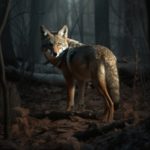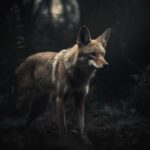Coyotes are among the most adaptable and resourceful predators in North America. They’ve captivated the minds of nature enthusiasts, and their cunning behavior has been a topic of interest for many. One question that often arises is: do coyotes hunt in packs? In this comprehensive, 2,000-word article, we will unravel the mystery behind coyote pack hunting and provide you with a step-by-step guide to understanding their behavior.
Coyotes: The Lone Hunters or Pack Predators?
Contents
Contrary to popular belief, coyotes are not strictly pack hunters. While they do have a social structure that may include families or small groups, they typically prefer to hunt alone or in pairs. However, there are instances when they will join forces to take down larger prey, such as deer, or defend their territory from potential threats.
To learn more about coyote hunting behavior, we’ll dive into the following topics:
- Coyote social structure
- Solitary hunting techniques
- Pack hunting behavior
- How to deter coyotes
1. Coyote Social Structure
Coyotes live in family units called packs that usually consist of a breeding pair and their offspring from previous years. This social structure allows for better cooperation when hunting, breeding, and raising their young. However, it’s important to note that not all coyotes live in packs – some, particularly younger individuals, may roam independently or join transient groups.
2. Solitary Hunting Techniques
When hunting alone, coyotes rely on their speed and cunning to catch their prey. They’re capable of reaching speeds up to 40 miles per hour, allowing them to quickly close in on their target. Additionally, their keen senses, agility, and intelligence make them efficient predators.
Coyotes will often use a stalk-and-pounce technique, where they slowly approach their prey before launching a surprise attack. They can also use their ability to jump to leap over obstacles and catch fleeing prey.
3. Pack Hunting Behavior
While coyotes typically hunt alone or in pairs, certain situations can prompt them to form temporary hunting packs. This behavior is often observed when they’re targeting larger prey, like deer, or defending their territory.
In these cases, pack members will work together to surround, harass, and tire out their prey before moving in for the kill. They may also employ distraction tactics, where one or more coyotes draw the prey’s attention while others approach from behind.
4. How to Deter Coyotes
If you’re concerned about coyotes on your property, there are several strategies you can implement to deter them. These include:
- Building a coyote-proof fence
- Scaring coyotes away with noise and light
- Reducing food sources by securing trash and pet food
- Clearing brush and debris from your yard
Additionally, educating yourself on coyote behavior and potential dangers can help you stay safe and coexist with these fascinating creatures.
Step-By-Step Guide: Do Coyotes Hunt in Packs?
Now that we’ve covered the basics of coyote behavior, let’s dive deeper into the factors that influence their decision to hunt in packs or alone. This step-by-step guide will help you better understand the conditions that drive coyotes to adopt different hunting strategies.
Step 1: Assess the Prey Size
Coyotes are opportunistic predators, meaning they will adjust their hunting strategy based on the size and type of prey available. Smaller prey like rabbits, rodents, and birds can be easily hunted by a single coyote. However, larger prey like deer may require the coordinated efforts of a pack to successfully bring down.
Step 2: Consider the Coyote’s Age and Experience
Younger, less experienced coyotes may be more likely to rely on pack hunting for support and guidance from older pack members. As they mature and become more proficient hunters, they may begin to hunt alone or in pairs more frequently.
Step 3: Examine the Local Coyote Population Density
In areas with a high coyote population density, it’s more likely for packs to form and engage in cooperative hunting. A larger number of coyotes in a given area can lead to increased competition for resources, making pack hunting a more efficient strategy.
Step 4: Evaluate Seasonal Factors
Coyote pack hunting behavior may also vary depending on the season. For example, during the winter months when food is scarcer, coyotes may be more inclined to hunt in packs to increase their chances of success. On the other hand, during the breeding season, mated pairs may prioritize raising their young and may hunt alone or in pairs to reduce competition for resources within the pack.
Step 5: Recognize Human Impact
Human activity can influence coyote hunting behavior as well. Increased urbanization and habitat fragmentation can lead to changes in prey availability and distribution, which in turn may impact the way coyotes hunt. In some cases, this may result in increased pack hunting behavior as coyotes adapt to their changing environment.
Expert Tips: Encountering Coyotes and Calling Them at Night
Whether you’re a wildlife enthusiast or a concerned property owner, understanding how to safely and responsibly interact with coyotes is essential. Here are a few expert tips to help you navigate encounters with these adaptable predators:
- Maintain a safe distance and avoid approaching or feeding coyotes
- If you encounter a coyote, make yourself appear larger and use loud noises to scare it away
- Keep pets on a leash and supervise them when outdoors
- Teach children how to respond if they encounter a coyote
For those interested in observing or photographing coyotes, calling them at night can be an effective technique. This involves using vocalizations, like howls or distress calls, to attract coyotes. However, it’s crucial to remember that this activity should be done responsibly and with the utmost respect for the animals and their environment.
Conclusion
So, do coyotes hunt in packs? The answer is both yes and no. While coyotes are primarily solitary hunters, they are also highly adaptable and can engage in pack hunting behavior when circumstances warrant. Factors such as prey size, coyote age and experience, population density, season, and human impact all play a role in determining their hunting strategies.
Frequently Asked Questions
How many are in a pack of coyotes?
Coyote pack sizes can vary, but they generally consist of a breeding pair and their offspring from previous years. A typical pack can range from 3 to 7 members, although larger packs are not unheard of, especially in areas with abundant resources.
What do coyotes hunt the most?
Coyotes are opportunistic predators, meaning they will prey on a wide variety of animals. Their diet primarily consists of small mammals such as rabbits, rodents, and birds. However, they will also consume insects, reptiles, amphibians, and even fruits and vegetables when available.
What do you call a pack of coyotes?
A group of coyotes is commonly referred to as a “pack.” This term is used to describe the family unit that consists of a breeding pair and their offspring.
What time of night are coyotes most active?
Coyotes are most active during the hours of dusk and dawn. These “crepuscular” animals take advantage of the lower light levels during these times to hunt and explore their environment. However, they have also been known to be active during the day and night, especially in areas with limited human activity.
Do coyotes bark like dogs?
Yes, coyotes can produce a wide range of vocalizations, including barks, howls, yips, and growls. While some of their vocalizations may sound similar to a dog’s bark, coyote calls have a distinctive, higher-pitched quality.
How big is a wolf compared to a coyote?
Wolves are generally larger and more robust than coyotes. Adult wolves can weigh between 70 and 150 pounds, while coyotes typically weigh between 20 and 50 pounds. Additionally, wolves have broader faces, larger feet, and longer legs compared to coyotes.
What is a coyotes biggest enemy?
Coyotes face several natural predators, including wolves, cougars, and bears. However, their biggest threat is often human activity, such as habitat loss, vehicle collisions, and intentional killings.
Will a coyote eat a coyote?
Coyotes are primarily carnivorous and will eat a wide range of animals, including smaller predators. While it is rare, they have been known to resort to cannibalism under extreme circumstances, such as severe food scarcity or territorial disputes.
What is the leader pack of a coyote?
The leader of a coyote pack is typically the breeding pair, which consists of a dominant male and female. These individuals will maintain control over the pack’s territory, make decisions about hunting strategies, and coordinate the care and protection of their offspring.





